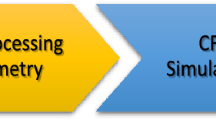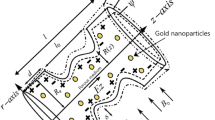Abstract
Vascular access (VA), a renal failure therapy, is often performed using an arteriovenous (AV) graft for patients with veins and arteries that cannot be connected with autologous blood vessels. However, VA using AV grafts can change the blood flow and lead to intimal hyperplasia (IH), causing the damage on blood vessel and failure of VA. In our study, we investigated the effect of the anastomosis angle on blood vessel damage under various IH formation conditions. We simulated the blood flow near the anastomosis between vein and AV graft and quantitatively evaluated the blood vessel damage using hemodynamic factors, such as wall shear stress (WSS). Our results show that smaller anastomosis angle reduces damage to blood vessels and prevents IH formation and growth regardless of IH progression, shape, and position. These results can contribute to optimization of the anastomosis angle during VA surgery to improve a patient’s prognosis.
Similar content being viewed by others
Abbreviations
- d vein :
-
Diameter of vein
- d graft :
-
Diameter of AV graft
- d p :
-
Distance between peak of the IH and the anastomosis
- p graft :
-
Pressure on inlet of AV graft
- \(\dot Y\) :
-
Shear rate
- h c :
-
Height of IH for concentric shape
- h e :
-
Height of IH for eccentric shape
- I :
-
Unit tensor
- μ 0 :
-
Viscosity at a shear rate of zero
- μ inf :
-
Viscosity at an infinite shear rate
- n :
-
Power index
- p :
-
Pressure
- λ :
-
Relaxation time
- ρ :
-
Density of working fluid
- t :
-
Time
- ϸ :
-
Venous anastomosis angle
- u :
-
Blood flow velocity vector
- w :
-
Width of IH
References
R. Saran et al., US renal data system 2019 annual data report: epidemiology of kidney disease in the united states, American Journal of Kidney Diseases, 75(1) (2020) A6–A7.
G. A. Beathard, Strategy for maximizing the use of arteriovenous fistulae, Seminars in Dialysis 13(5) (2000) 291–296.
V. Misanovic et al., Central venous catheter as vascular approach for hemodialysis-our experiences, Materia Socio-Medica, 27(2) (2015) 112.
S. K. Kakkos et al., Effectiveness of a new tunneled catheter in preventing catheter malfunction: a comparative study, Journal of Vascular and Interventional Radiology, 19(7) (2008) 1018–1026.
National Kdney Foundation, I. NKF-K, DOQI clinical practice guidelines for hemodialysis adequacy: update 2000, Am J Kidney Dis, 37(1) (2001) S7–S64.
M. J. Brescia et al., Chronic hemodialysis using venipuncture and a surgically created arteriovenous fistula, New England Journal of Medicine, 275(20) (1966) 1089–1092.
J. M. MacRae et al., Arteriovenous access failure, stenosis, and thrombosis, Canadian Journal of Kidney Health and Disease, 3 (2016) 2054358116669126.
P. Miao et al., Long-term patency and comparisons of venous outflow in hemodialysis forearm arteriovenous grafts, Vascular, 30(2) (2022) 238–245.
B. Ene-Iordache and A. Remuzzi, Blood flow in idealized vascular access for hemodialysis: a review of computational studies, Cardiovascular Engineering and Technology, 8(3) (2017) 295–312.
H. Haruguchi and S. Teraoka, Intimal hyperplasia and hemodynamic factors in arterial bypass and arteriovenous grafts: a review, Journal of Artificial Organs, 6(4) (2003) 227–235.
M. Ojha et al., Influence of angle on wall shear stress distribution for an end-to-side anastomosis, Journal of Vascular Surgery, 19(6) (1994) 1067–1073.
R. S. Keynton et al., The effect of angle and flow rate upon hemodynamics in distal vascular graft anastomoses: an in vitro model study, Journal of Biomechanical Engineering, 113(4) (1991) 458–463.
A. M. Malek et al., Hemodynamic shear stress and its role in atherosclerosis, JAMA, 282(21) (1999) 2035–2042.
P. Roy-Chaudhury et al., Hemodialysis vascular access dysfunction: a cellular and molecular viewpoint, Journal of the American Society of Nephrology, 17(4) (2006) 1112–1127.
T. Meirson, et al., Flow patterns in externally stented saphenous vein grafts and development of intimal hyperplasia, The Journal of Thoracic and Cardiovascular Surgery, 150(4) (2015) 871–879.
L. Peng et al., Numerical simulation of hemodynamic changes in central veins after tunneled cuffed central venous catheter placement in patients under hemodialysis, Scientific RePorts, 7(1) (2017) 1–8.
Z. Bai and L. Zhu, 3D simulation of a viscous flow past a compliant model of arteriovenous-graft annastomosis, Computers & Fluids, 181 (2019) 403–415.
G. Prouse et al., Computational analysis of turbulent hemodynamics in radiocephalic arteriovenous fistulas to determine the best anastomotic angles, Annals of Vascular Surgery, 68 (2020) 451–459.
F. Kabinejadian et al., Sequential venous anastomosis design to enhance patency of arterio-venous grafts for hemodialysis, Computer Methods in Biomech. Biomed. Engin., 20(1) (2017) 85–93.
D. Williams et al., Tailoring of arteriovenous graft-to-vein anastomosis angle to attenuate pathological flow fields, Scientific Reports, 11(1) (2021) 1–10.
M. Ngoepe et al., A numerical tool for the coupled mechanical assessment of anastomoses of PTFE arterio-venous access grafts, Cardiovascular Engineering and Technology, 2(3) (2011) 160–172.
L. Zhu and K. Sakai, Simulation of blood flow past distal arteriovenous-graft anastomosis with intimal hyperplasia, Physics of Fluids, 33(5) (2021) 051905.
R. Berguer et al., Intimal hyperplasia: an experimental study, Archives of Surgery, 115(3) (1980) 332–335.
J. Lee et al., Assessing radiocephalic wrist arteriovenous fistulas of obtuse anastomosis using computational fluid dynamics and clinical application, The Journal of Vascular Access, 17(6) (2016) 512–520.
S. Quicken et al., Computational study on the haemodynamic and mechanical performance of electrospun polyurethane dialysis grafts, Biomechanics and Modeling in Mechanobiology, 19(2) (2020) 713–722.
T. Lee and N. U. Haq, New developments in our understanding of neointimal hyperplasia, Advances in Chronic Kidney Disease, 22(6) (2015) 431–437.
A. Leuprecht and K. Perktold, Computer simulation of non-Newtonian effects on blood flow in large arteries, Computer Methods in Biomechanics and Biomedical Engineering, 4(2) (2001) 149–163.
S. Cho et al., Development of new hemodialysis catheter using numerical analysis and experiments, ASAIO Journal, 67(7) (2021) 817–824.
S. C. Park et al., Fabrication of artificial arteriovenous fistula and analysis of flow field and shear stress by using μ-PIV technology, Journal of Mechanical Science and Technology, 30(12) (2016) 5503–5511.
T. W. Clark et al., Computational flow dynamics and preclinical assessment of a novel hemodialysis catheter, Seminars in Dialysis, 25(5) (2012) 574–581.
X. He and D. N. Ku, Pulsatile flow in the human left coronary artery bifurcation: average conditions, Journal of Biomechanical Engineering, 118(1) (1996) 74–82.
Acknowledgments
This work was supported by the Basic Science Research Program through a National Research Foundation of Korea (NRF) grant funded by the Ministry of Science, ICT & Future Planning (NRF2020R1A2C3010568), the Basic Science Research Program through the NRF funded by the Ministry of Education (NRF2021R1A6A1A03039696), and SKKU-SMC Future Convergence Research Program grant.
Author information
Authors and Affiliations
Corresponding authors
Additional information
Sun Cheol Park, M.D., Ph.D., RVT, RPVI, received his M.D., M.S. and Ph.D. from The Catholic University of Korea, Korea. Since 2004, he has been a Professor at Department of Surgery of The Catholic University of Korea, Korea. His surgical and research interests include transplant and vascular surgery, vascular access and hemodynamic simulations.
Jinkee Lee, Ph.D., received his B.S. and M.S. degrees from Korea Advanced Institute of Science and Technology, and his Ph.D. from Brown University, USA. Since 2012, he has been a Professor at the School of Mechanical Engineering and Institute of Quantum Biophysics of Sungkyunkwan University, Korea. His research interests include interfacial flow, microfluidics, biomimetics and biofluidics.
Rights and permissions
About this article
Cite this article
Mok, S., Cho, S., Lee, J. et al. Optimizing venous anastomosis angle for arteriovenous graft with intimal hyperplasia using computational fluid dynamics. J Mech Sci Technol 37, 5231–5238 (2023). https://doi.org/10.1007/s12206-023-0925-4
Received:
Revised:
Accepted:
Published:
Issue Date:
DOI: https://doi.org/10.1007/s12206-023-0925-4




